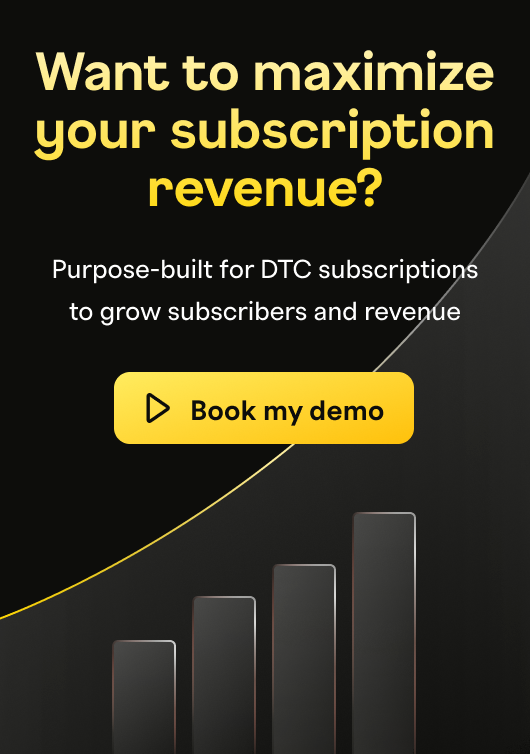Payment orchestration for subscriptions: What you need to know

Subscription businesses lose millions when payments fail in different regions and with various payment methods. Handling transactions in multiple currencies, ensuring seamless integration of payment methods, and adapting to multiple payment gateways all add complexity that affects the success of your payment strategy.
Businesses also struggle when gateways go offline, cards get declined in certain regions, or payment methods aren't available where customers live. Each failed payment costs the company that month's subscription fee and risks losing the customer permanently.
Building custom solutions to handle these problems requires engineering teams to manage multiple gateway integrations, develop retry logic, and maintain failover systems, which is the kind of complexity that subscription management platforms handle automatically.
Payment orchestration systems centralize and automate payment routing to reduce failed transactions and improve customer experience.
Key takeaways:
What is payment orchestration? Payment orchestration is a system that centralizes and automates payment processing by intelligently routing transactions across multiple payment gateways. Its primary goal is to reduce failed payments, decrease involuntary churn, and optimize transaction costs
Why it's critical for subscription businesses: For recurring revenue models, failed payments directly result in lost revenue and customer churn. Payment orchestration is essential for mitigating these losses, especially when expanding internationally and dealing with multiple currencies, payment methods, and gateways
Payment orchestration vs. a payment gateway: A payment gateway is a single service that processes transactions. A payment orchestration platform manages the entire payment ecosystem, directing transactions to the optimal gateway based on merchant direction to improve success rates—it manages the gateways, rather than just being one
Core features and benefits: Key features include intelligent retry logic, multi-gateway routing with automatic failover, and support for global payment methods. These lead to measurable benefits like higher payment authorization rates, reduced involuntary churn, lower transaction costs, and faster international expansion
How success is measured: The effectiveness of a payment orchestration strategy is measured by key metrics such as the increase in payment authorization rates, the reduction in involuntary churn, the total revenue recovered from previously failed payments, and the overall savings on transaction costs
Why is payment orchestration important for subscription businesses?
Payment orchestration matters now for recurring billing models because failed subscription payments cause customers to cancel, which diminishes the overall lifetime value of the customers.
Failed payments cost subscription revenue directly: Subscription businesses lose revenue due to failed payments
International expansion increases payment complexity: Companies need to handle local currencies, support regional payment methods, and comply with varying tax regulations, while subscribers expect multiple payment options and frictionless payment experiences when managing recurring subscriptions globally
Subscription economy growth demands complex billing infrastructure: The subscription economy grew from $650 billion in 2020 to an estimated $1.5 trillion by 2025. Subscribers now expect plan flexibility, usage-based pricing, pause options, and mid-cycle changes. Businesses compete by offering hybrid models combining fixed fees, usage tiers, and add-ons that legacy billing systems cannot handle without custom development
Payment orchestration prepares companies for failover and reliable scaling: Automatic failover switches to backup gateways during downtime, while intelligent routing distributes volume and maintains payment processing during high-traffic periods
Payment orchestration vs payment gateway
Payment gateways and payment orchestration serve different functions in subscription billing systems. Payment gateways handle static transactions between customers and merchants, while payment orchestration manages multiple gateways to reduce failed payments and improve revenue recovery. Understanding these differences helps subscription businesses choose the right payment infrastructure for their recurring revenue model.
Transaction scope differs significantly: Payment gateways process individual transactions one at a time, while orchestration systems manage and route transactions through multiple gateways simultaneously based on real-time performance data
Recurring billing capabilities vary: Gateways lack built-in retry logic and automatic failover systems that subscription businesses need when payments fail, forcing manual intervention for declined recurring charges
Transaction costs decrease through intelligent routing: Orchestration reduces processing fees by sending transactions to the lowest-cost gateway for each specific transaction type, region, or currency. Merchants can choose the best route for their transactions to minimize cost and failure
Compliance management becomes centralized: Orchestration platforms handle PCI DSS compliance (security standards for processing card payments) for all connected gateways through one unified system, rather than managing separate compliance for each gateway
How payment orchestration functions for subscriptions
Payment orchestration automates the entire recurring payment process from initial transaction routing through failure recovery. The system makes real-time decisions about where to send each payment attempt and automatically handles failed transactions without manual intervention.
Transaction routing uses multiple data points: Merchants can route payments based on customer location, payment method type, and historical success rates for similar transactions through the right gateway
Machine learning algorithms make real-time decisions: Platforms analyze transaction patterns and gateway performance to help you choose the best processing route for each payment attempt
API connections integrate with existing systems: Orchestration platforms connect through APIs and manage webhooks to synchronize payment data with subscription billing systems
Automated retry logic handles failed payments: Systems automatically reattempt failed payments using customizable schedules and rules based on decline reason codes
Tokenization secures stored payment credentials: Platforms use payment vaults to store encrypted customer payment information safely for future recurring charges
Dunning campaigns trigger after payment failures: Automated email and SMS campaigns activate when payments fail to collect updated payment information from customers
6 Payment orchestration features that matter for subscriptions
Payment orchestration platforms include features designed specifically for recurring billing challenges. These capabilities help subscription businesses reduce payment failures, maintain customer relationships, and scale internationally without manual payment management.
1. Intelligent payment retry logic
Automated retry schedules reduce involuntary churn by timing attempts when customers are most likely to have funds available. Companies use this to retry failed monthly payments 3-5 days after payday cycles, while subscription box services time retries before monthly delivery dates.
2. Multi-gateway routing and failover
Merchants can direct transactions to the highest-performing gateway based on location, payment method, currency, and other factors. Streaming services route high-value annual subscriptions through premium gateways with better authorization rates, while routing smaller monthly payments through cost-optimized processors.
3. Payment method tokenization and updates
Payment tokenization replaces sensitive card data with secure tokens that enable recurring billing without storing actual card numbers, reducing PCI compliance scope and fraud risk. Tokens allow seamless payment method switching, backup payment failover, and cross-platform billing continuity. Automatic card updater services build on this foundation by maintaining current payment information to prevent subscription interruptions, automatically updating expired cards without requiring customers to manually enter new payment details when cards are reissued.
4. Global payment method coverage
Access to local payment methods and currencies removes barriers to international subscription growth. Software companies expanding into Europe can accept SEPA direct debits, while those entering Asian markets can process payments through regional digital wallets and bank transfers.
5. Dunning campaign automation
Coordinated email and SMS campaigns to recover failed payments while maintaining positive customer relationships. Fitness subscription apps send personalized payment reminders with account pause options instead of immediate cancellations, giving customers time to resolve payment issues.
6. Payment analytics and revenue reporting
Centralized dashboards track authorization rates, churn patterns, and revenue recovery through all payment channels. Subscription e-commerce businesses use these reports to identify which payment methods cause the most failures and adjust their payment mix accordingly.
Benefits of payment orchestration for subscription revenue
Payment orchestration delivers measurable improvements to subscription business metrics through automated payment management and intelligent routing. These systems directly impact revenue retention, operational costs, and growth capabilities for recurring billing models.
Lower transaction costs
Routing optimization reduces payment processing fees while maintaining high success rates. Payment orchestration automatically selects the most cost-effective gateway for each transaction based on location, currency, payment method, and transaction value.
Reduced involuntary churn
Automated retry logic and backup payment methods prevent subscription cancellations from failed payments. Systems automatically attempt failed payments using different timing and gateway combinations while triggering personalized in-app messages at the optimal moment to guide subscribers through payment updates, plan changes, or retention offers before triggering cancellation workflows.
Increased payment authorization rates
Smart routing improves success rates compared to static-gateway processing. Orchestration platforms route transactions to gateways with the highest approval rates for geographic regions, customer profiles and payment types.
Faster international expansion
Integration provides access to local payment methods in global markets without individual gateway contracts and optional Merchant of Record services that handle tax compliance, chargebacks, and regulatory requirements across 60+ jurisdictions. Businesses can accept payments in new countries immediately rather than spending months negotiating separate gateway agreements.
Reduced manual payment management
Centralized payment controls eliminate ad hoc gateway switching decisions and reduce repetitive technical maintenance tasks. Teams manage all payment routing, retry logic, and failure handling, and merchant record updates through one unified dashboard instead of multiple gateway interfaces.
Top challenges of implementing payment orchestration
Payment orchestration implementation presents technical and operational hurdles that subscription businesses must address before realizing benefits. These challenges require planning, resources, and expertise to navigate successfully during the transition from single-gateway processing.
Integration complexity and technical resources
Connecting multiple payment service providers requires development time, ongoing maintenance, and analytics-driven decision making. Engineering teams must build and maintain separate integrations for each gateway while using transaction data to determine which payment methods to add or remove and ensuring data flows correctly between systems.
Data management and reporting consolidation
Aggregating payment data from multiple sources into actionable insights demands a robust analytics infrastructure. Businesses need unified reporting systems that can normalize transaction data from different gateways into consistent metrics and dashboards.
Security and compliance requirements for multiple providers
Managing PCI DSS compliance, fraud detection, and data protection standards through payment channels increases operational burden. Security teams must ensure all connected gateways meet compliance requirements while maintaining consistent fraud monitoring protocols.
Routing rule configuration and optimization
Setting up routing logic requires understanding customer behavior patterns and payment success factors. Teams must analyze transaction data to create rules that balance cost optimization with authorization rates for different customer segments.
Testing and quality assurance
Validating payment flows through multiple gateways and scenarios before launch prevents revenue disruption. QA teams must test all payment combinations, failure scenarios, and retry sequences to ensure the system works correctly in production.
Key metrics for measuring payment orchestration success
Subscription businesses need specific metrics to evaluate payment orchestration performance and return on investment. These measurements track both immediate payment improvements and long-term revenue impact from automated payment management systems.
Payment authorization rate improvement
Track authorization rate increases through customer segments and payment methods to measure routing effectiveness. Businesses compare pre-orchestration approval rates against post-implementation rates, segmented by geography, payment type, and customer value to identify which routing decisions drive the biggest improvements.
Involuntary churn reduction
Measure decreases in subscription cancellations due to payment failures to quantify retention improvements. Companies calculate the percentage of subscribers who would have churned from failed payments but were retained through automated retry logic and backup payment methods.
Revenue recovery from failed payments
Calculate additional revenue captured through retry logic and dunning campaigns that would have been lost permanently. This metric tracks the dollar amount of previously failed payments that were successfully processed after automated recovery attempts.
Transaction cost optimization
Monitor payment processing fee reductions from smart routing decisions to measure cost savings. Businesses compare average transaction costs before and after orchestration implementation, tracking how intelligent gateway selection reduces overall payment processing expenses while automated compliance updates eliminate manual tracking of PCI requirements, regional payment regulations, and gateway-specific rule changes
Why Recurly is the best solution for payment orchestration
Subscription businesses need payment orchestration that integrates directly with recurring billing logic and customer lifecycle management.
Recurly combines payment orchestration with subscription management, providing automated retry campaigns, payment method updates, and churn prevention tools that increase revenue retention.
Payment orchestration integration with recurring billing:
20+ payment gateways with automatic gateway failover when transactions fail
Custom gateway routing that directs payments to gateways based on business needs
Automatic transaction routing based on accepted card type and currency
Automated retry campaigns and machine learning:
Intelligent retry engine that uses machine learning to retry declined transactions when and how the transaction is most likely to be accepted
Analytical models use data points from millions of historical transactions to generate customized retry schedules for each invoice
Automatic Account Updater that monitors customers' credit cards for changes and updates, and Recurly records as needed
Pause and unpause subscription options
Customer billing updates triggered by merchant communications
One-click plan changes that prevent cancellations
Payment method updates:
Expired card management that automatically updates account billing data before recurring billing to keep card data fresh and accurate
Recurly supports Klarna through Stripe integration, offering Buy Now Pay Later (BNPL), Pay Now, and Pay Later options
Backup payment method for each subscriber used when the primary payment method fails
Churn prevention tools:
Multiple dunning campaigns that can be assigned to plans and accounts for tailored customer communication
Recurly Engage can help you predict churn before it happens and delivers real-time personalized cancellation flows across web, mobile, and TV platforms.
Subscribers can make plan changes, add services, or pause subscriptions with one click, preventing cancellations through flexible retention options rather than just measuring failed payment recovery.
Industry-leading 96% renewal invoice paid rate for businesses
Multi-gateway and currency management:
Support for 140+ currencies and regional/global payment methods such as Venmo, Apple Pay, Amazon Pay, ACH, BACS, BECS, and SEPA Direct Debit
Revenue recovery analytics:
$1.3 billion in total revenue recovered through comprehensive churn management
72% of at-risk subscribers saved using recovery events across multiple touchpoints
Average drop in involuntary churn from 6% to 1% using Recurly's churn management model
Book a demo to see Recurly's subscription payment orchestration

